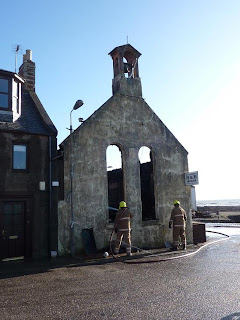I took the coast road to Dundee - a much more pleasant journey than the dual carriageway, (and with more possible venues for the leaflets) - and found I arrived in the city much earlier than expected. So, with no need to hurry home, I decided to take my time and explore a bit.
I've wanted to visit the Frigate Unicorn for a long time, but have never quite got around to it. So yesterday, assuming it would be closed, I drove down to the dock where it is berthed.
What an amazing ship this is! It sits amongst modern buildings, looking somewhat out of place. The entire Dundee Waterfront is undergoing massive regeneration at the moment with the first V&A museum outside London being located here in the next few years. As part of this development, Unicorn will be relocated as a centrepiece of the Central Waterfront area.
If you look closely you'll see that there were painters working on the outside, getting it ready for the new tourist season. I poked my head in through the door and was delighted to see that it was actually open - in fact it was the first day of opening this year, and I was the very first visitor!!
HMS Unicorn was launched in 1824 as part of a programme to re-equip the navy following the Napoleonic wars. Under normal circumstances she would have been rigged, but this was a time of peace, so instead she was roofed over for protection, put into reserve and used for training purposes.
Frigates like this were heavily armed - each window once housed a cannon - 46 in total.
 |
| Captain's cabin |
The very friendly and informative man at the Unicorn was very happy to do a leaflet swap with me, so if you want to find out more about the ship you can pick up a leaflet from my shop.
I went on to the Tourist Information Centre at Discovery Point. This is home to Captain's Scott's famous ship, RMS Discovery, which, along with the polar explorers exhibition is well worth a visit. You can read more about it at http://www.rrsdiscovery.com/
Whilst there I picked up a leaflet for an exhibition called 'And So to Embroider' at the University of Dundee. It was only a ten minute walk away, so I went to explore. This is a collection of pieces that were gathered by the Needlework Development Scheme from 1934-1961. Run by Scotland's four art colleges, the scheme toured the world collecting examples of historic and contemporary needlework to form a national educational resource. Click here to see the archive.
They have pieces from all over the world, but it was the early 20th century British work that fascinated me the most.
It's difficult to pick a favourite, but I really like this lion which was worked in Britain by M Nash in 1946. It's a shame that the name is just recored as 'M Nash' - what was her first name?
Several examples had no name at all, which I find quite sad. It got me thinking about ways of incorporating my own name into my textile work. Signing a painting is easy, stitching the right thing in the right place needs a bit more thought.
So, if you ever find yourself with some 'me' time, I urge you to make the most of it. Explore those places that are fairly close to home and you've always meant to visit but have never quite got around to!





















































